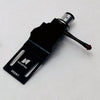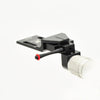



NASOTEC Swing Headshell 203A1 BLACK
HIFI Choice review :
“One of the problems with a conventional tonearm is that the cartridge follows an arc as it tracks the groove from the outside of an LP to the inside. When an LP is first cut at the studio, the groove is etched using a lathe that is tracked straight across the radius of the record in a linear manner. Ideally, a cartridge should also track the record linearly during playback, but linear tracking tonearms are often expensive.
Swing out sister
The compromise is to use a pivoting tonearm, but this means the stylus is only perpendicular to the groove at two points along the arc. The Swing Headshell 202A1 addresses the variance at the other parts of the arc by twisting the cartridge as it plays using the force from the drag of the stylus in the groove. Using a Lyra Clavis DC moving-coil cartridge fitted to the headshell of a Jelco SA-750 tonearm on an ISOkinetik Modular 1.5 turntable (HFC 371), I connect the supplied cartridge leads, adjust the springs and set the tracking weight accordingly. I can see that the reference hairlines on the headshell are correctly lined up and I move the arm to start playing an LP. Cueing is a little tricky as the cartridge tends to wobble as I move the tonearm into position. Compared with my usual fixed headshell, the differences are very subtle, but I experience a little more air around instruments, regardless of the position of the arm across the record – suggesting the mechanism is doing its stuff and may result in even greater benefits on other tonearms.”


